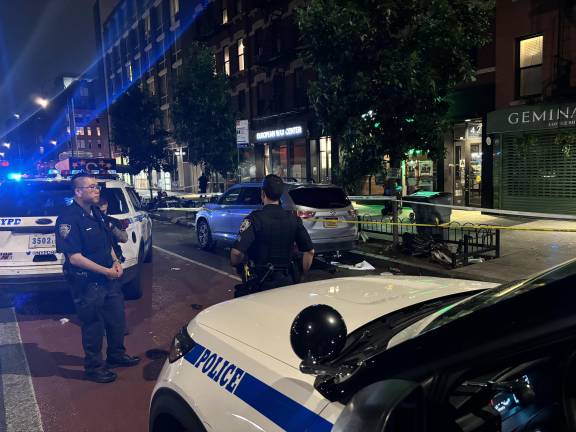When Will Mobile NYPD Center on East Side Be Deployed?
A mobile command center promised for East 14th Street last summer is still not there. Will a new Quality of Life division that NYPD Commissioner Jessica Tisch unveiled recently help improve things?

Last summer, after a violent altercation on East 14th Street left one person dead and two injured, Mayor Eric Adams and then-Police Commissioner Edward Caban announced that the NYPD would be deploying a mobile command center to the location. The command center was meant to coordinate between the two police precincts that meet there—the 9th Precinct in the East Village and Lower East Side and the 13th Precinct in Stuyvesant Town, Union Square, and Mid-town East—and agencies providing social services, homeless assistance, and health care. The City Council allocated $1 million to purchase the vehicle and equipment. That street—a few blocks of East 14th from Second Avenue to Avenue B—had been (and remains) a source of complaints from residents and a clearly identified “hotspot” of criminal activity, from drug dealing to harassment to selling of stolen goods.
Now, almost nine months later, the command center has yet to be deployed, another example of the Adams administration’s lack of planning, focus, and follow-through when it comes to public safety. As the city continues to deal with the aftereffects of the nationwide crime wave that coincided with the COVID-19 pandemic, identifying safety priorities—and developing effective strategies to pursue them—will become increasingly important, and must be pursued with an eye toward data-driven policymaking and evidence-based solutions.
Throughout my career in public service, I have worked to incorporate data-driven policymaking into government, where decisions are often reactive and bureaucracies are notoriously resistant to change. The police have been no exception to that, but to address New Yorkers’ concerns about safety in the streets and subways, we will need to prioritize effectiveness first and politics second: investing in mental health care and housing to address street homelessness while deploying NYPD resources to areas with the highest demonstrated impact on crime. For instance, statistics from the NYPD’s Transit Bureau show that roughly 80 percent of crimes committed in the subway system occur on the train or the platform, but deployments on Manhattan’s East Side are consistently concentrated around the station entrances, too far from the platform to intervene in time to deter or prevent a serious incident. Learning from and responding to these patterns is the core of a sound policing strategy, and requires consistent, methodical reassessment of priorities and deployments in order to be done well.
Recently, there has been progress on the data-driven policing front. Police Commissioner Jessica Tisch, who replaced Commissioner Caban this past November, has taken several long-overdue steps to implement data-driven strategies at the department and effectively address crime. In December, the NYPD announced it would no longer be using “telephone message transfers” to redeploy officers, a practice that left many precincts understaffed and made it impossible for NYPD leadership to account for—much less strategically deploy—hundreds of officers. In early April, the department launched a new Quality of Life division to police low-level offenses like aggressive panhandling and illegal street vending; in announcing the new division, Commissioner Tisch assured the public that its deployments would be based on data derived from 311 complaints, an important break from the “dragnet” strategies that have characterized dealing with quality-of-life crimes in the past and created the potential for civil rights abuses. The 13th Precinct, which covers half of East 14th Street, will be one of the first to deploy this new division.
Around the country, Republican politicians use high-profile incidents of crime in NYC to fearmonger, exaggerating the dangers of living here and painting a picture of New York as a city without a future. I will never accept that. We can address New Yorkers’ safety concerns about our streets and subways without turning to this kind of demagoguery, and without demonizing law enforcement. By taking a methodical, level-headed, and evidence-based approach to crime, we can restore confidence in our neighborhoods while continuing to celebrate the city we love. New Yorkers don’t deserve anything less.
Benjamin Wetzler is a former Upper East Side Democratic Party District Leader and a candidate for New York City Council in District 4.
Commissioner Tisch assured the public that its deployments would be based on 311 complaints, an important break from the “dragnet” strategies of the past.